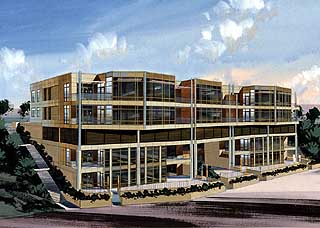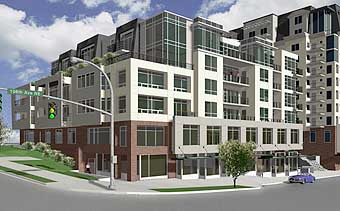
Urban Development
DJC.com
Next >
Back <
Too much too soon?
Rapid growth can bring crisis in construction quality
Most buyers are not literate when it comes to the structural integrity of a building. They don’t see what lies behind the walls, and buying decisions are often based on short-term considerations such as affordability.
By BRIAN BRAND
and TOM FRYE
Baylis Architects
The rapid transformation of the Seattle metropolitan area over the last 10 years has brought exciting change as well as controversy. Increased population and growth management have resulted in a more urban environment, and increased demand for affordable housing. But the need to find quicker ways to meet the demand for housing has resulted in a rash of building failures throughout the Northwest and Vancouver, British Columbia. In fact, construction quality issues have reached crisis proportion.

|
With the squeeze on supply driving up land costs, permits and impact fees, many developers have opted to cut costs on materials, structure and labor in order to be competitive in a fast-paced sales market. Ten years later, we are beginning to see the results of this short-term approach to building density. There are almost as many failing buildings covered in scaffolding and plastic as there are new buildings under construction.
The truth is, most buyers simply are not literate when it comes to the structural integrity of a building. They don’t see what lies behind the walls, and buying decisions are often based on short-term considerations such as affordability. Consumers naturally assume that what they are buying has structural integrity and will withstand the wet climate. The irony is that people who have purchased low-cost housing are the least able to afford the often huge cost of repairing problems that surface years later.
Numerous factors contribute to building failure. In the Northwest, the leading destroyer of a building’s integrity is water intrusion. The moist climate of our region makes buildings here especially susceptible to water damage. This is especially true in multi-family projects where windows, doors, vents and other areas can allow moisture to enter. Low cost multi-family housing is often wood frame construction. Although more affordable than concrete or steel, it has the least integrity when it gets wet.
Many of these high-density housing projects, built to four or five stories, are especially vulnerable to water damage because their height leaves them exposed to high wind pressures. Roof overhangs generally protect only the top portion of the building.
Further exacerbating the problem, recent Washington state energy codes require tighter construction to reduce heat loss. Any water that gets in can become trapped, causing extensive damage over the long term.
If a wood frame building is poorly constructed, the problem becomes even worse. Product failure also happens because manufacturers often make exaggerated claims about a product’s integrity. If comprehensive failure testing based on local weather conditions is not done, a poor quality product can fail and require replacement prematurely.
The sensible solution requires, foremost, knowledge of what it takes to construct a building correctly. This means more accountability on the part of developers, architects, engineers and contractors. Second, owners and developers need to realize that spending more money initially on high-quality construction and knowledgeable consultants is going to be more cost effective than repairing poorly constructed buildings.
Higher-quality structural materials like concrete and steel, although more costly and labor intensive initially, have a much higher tolerance to water intrusion. Other benefits include improved fire ratings, improved strength and seismic integrity, and better sound insulation.
To avoid water intrusion in the Northwest, backup drainage systems must be used. Water often finds its way behind siding systems. Membranes placed between exterior siding and walls, with proper flashing, provide an unobstructed path for water to escape without causing structural deterioration. Better materials used with exterior cladding systems are also essential to the integrity of a building. Possibly the most critical key to a building’s integrity is to hire an experienced team, including a waterproofing consultant to assist from design through construction, to ensure the project is built properly.
Several Eastside projects are using higher-quality materials and systems to ensure longevity. The Palazzo, designed by Baylis Architects, consists of four stories of stacked multi-family units over one story of office and one story of retail. The building will be constructed of post-tensioned concrete frame with a “window wall” cladding system. This system includes walls, cladding and windows made and installed by the same manufacturer. The panels are engineered and prefabricated by one manufacturer, eliminating the need for a wall assembled by multiple subcontractors, which improves quality assurance.
The window wall includes internal backup drainage systems, which allow for inevitable infiltration of water, by providing channels and weep holes to return moisture to the exterior. These panels are constructed of powder-coated, steel-reinforced aluminum. Care will be taken to coordinate construction details on glass, structure and cladding systems with the architect, contractor and subcontractors. A waterproofing consultant who was experienced with this type of building and cladding system was hired for assistance through all phases of the project.

|
Another medium-density housing project by Baylis Architects, The Waterford at Des Moines, is breaking ground this summer. Though its stacking arrangement — two levels of “flats” over a level of parking atop two-story town homes — is somewhat unusual, the building uses high-quality, durable materials such as a curtain wall and aluminum sandwich panel wall system to enclose a steel-framed structure. Due to its location on a steep bluff overlooking Puget Sound, a concrete base will be used to secure it into the hill. The sturdy base also helps stabilize the hillside against potential landslides. Steel provides strength and durability, and the commercial-grade curtain wall system will provide optimum weather protection, which is critical given the location and exposure to weather. To prevent water intrusion, the building was designed with a sophisticated drainage system and a rain-screen system to keep moisture out. A waterproofing consultant was also hired for this project through all construction phases.
The push for higher-quality structures must come from the building industry itself. As more people become aware of the costs associated with poor quality, we can begin moving away from short-term quick fixes and move toward high-quality buildings with long-term integrity.
Steps have been taken to educate the public. In recent months, the U.S. Department of Housing and Urban Development has teamed with the AIA and several other organizations to launch a new Web site called the Affordable Housing Design Advisor (www.designadvisor.org). The site is aimed at educating the community at large since this issue is something that affects everyone. With continued urbanization an inevitable reality, it is critical that we all become more educated about building with integrity the first time around.
Brian Brand is president of Baylis Architects and Tom Frye is a principal.
Top | Back | Urban Development | DJC.com Copyright ©1995-2000 Seattle Daily Journal and djc.com.
Comments? Questions? Contact us.